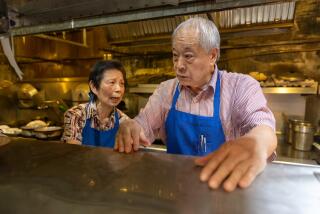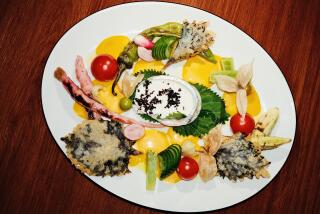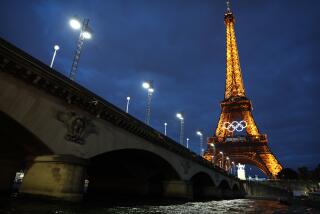COLUMN ONE : French Bid Adieu to Their Cafes : Their number has diminished by more than two-thirds in 30 years, as fast-food franchises and at-home entertaining have increased. But for many, their disappearance leaves a void nothing else can fill.
PARIS — It was only a small, run-down Parisian cafe, wedged between the high-gloss facades of fashion boutiques on the Avenue Montaigne.
But it was the last cafe in the neighborhood--the last warm, smoky retreat where office workers and local residents could go to lean against the stainless-steel comptoir , down a short, bitter cup of coffee and trade insults with the waiters.
So when the Cafe les Essais closed down a few months ago to be replaced by yet another trendy, impossibly expensive, high-fashion boutique, the cafe regulars were suddenly set adrift, anchorless in a cold and hostile world.
“I felt orphaned, empty,” said Gislaine Pinatel, 41, a fashion journalist who works on the Avenue Montaigne. “I spent my life in that cafe. I was there every morning for my first coffee, back at 11 for another cup and at noon to eat a sandwich or have lunch. Mostly I was there to see people. A good cafe is like a village--a village where you have a family at the corner cafe.”
Cafe habitues are going into similar withdrawal all over France.
The neighborhood cafe, one of France’s most important cultural and social institutions, is rapidly disappearing from the country’s cities and villages--the victim, to describe the demise in its broadest terms, of refrigeration, television and the hamburger.
In 1960, there were 200,000 licensed cafes in France. This year, according to an estimate by cafe owner Robert Henry, the colorful president of the National Union of Restaurant, Cafe and Hotel Owners, the number has dropped to fewer than 60,000. “Each time a cafe disappears,” said Henry, 71, serving a visitor a hot rum to help soothe a chest cold, “a little in the life of the neighborhood goes with it.”
In Paris and the major cities, the disappearance has been forced by rising real estate prices and the gentrification of former working-class neighborhoods. The blue smoke of Gauloise cigarettes and the husky voice of chanteuse Edith Piaf have been pushed out by haute couture boutiques and chain sandwich shops.
As France’s rural population ages and disappears, so do its cafes. At the end of World War II, more than 30% of the French population still lived in rural areas. By 1990, the rural population had dropped to less than 6%. Towns that once boasted several cafes suddenly found themselves unable to support even one.
Desperate to retain at least one cafe, often the only communal gathering place in town, some villages have taken the radical step of purchasing and operating cafes with public money.
“A cafe is part of the life of the countryside,” explained Louis Congny, mayor of the tiny village of Poil (215 inhabitants) in the Nievre region of central France. A few years ago, Poil bought a local bakery shop and converted it into a cafe for its citizens.
“It’s a meeting place,” Congny continued. “It’s a place where someone who wants to sell a dog or a cow can put up a notice. Imagine if we had a funeral service. After the burial, the custom is for everyone to go to the cafe and clink glasses. What would we do if we didn’t have a cafe? Everyone would go back home. There would be no discussion.”
In the bigger cities, surviving cafe owners have attempted to fight the decline of the cafe by sponsoring educational reforms to attract more qualified, economically savvy young people to the business. Since 1990, French technical high schools have offered two-year degrees in cafe- brasserie management.
The cafe owners try to put a brave face on the decline. But they feel assaulted on all sides--by the American-style fast-food restaurants that have captured the best corners in the cities, by changing drinking habits that mean more French prefer to take their aperitifs at home in front of the television set, and by a new smoking law, in effect since Sunday, that requires all cafes in France to create smoking and nonsmoking sections.
Many of the smaller cafes are not big enough to subdivide along smoking lines. The French cafe without its permanent hovering cloud of smoke and carpet of discarded butts, so annoying to visiting Americans long accustomed to smoking segregation, is practically unimaginable.
“It is not a pretty picture these days,” said Henry, who remembers doing his homework at the zinc bar of his father’s cafe. “But we haven’t given up hope. People still need us. We know that we still have a social role to play--to relax the public, let them exchange ideas and give them a different climate than that of their apartment or factory.”
Certainly some cafes will remain. Henry estimates that as many as 50,000--mainly bigger, better-managed cafes such as his Cafe au Petit Poucet on the Place de Clichy--will survive.
But the great French cafe age, stretching back 300 years to the days when the 18th-Century writer and philosopher Voltaire used to take his coffee at the Left Bank’s Cafe Procope, is clearly over.
The Cafe Procope, still in existence, is now an expensive restaurant that is owned by a national chain.
The smoky retreats from the rain and the cold, where the owners know the names of all their regular clients and those of their children, are disappearing. So are the small bistros with the rickety round tables where would-be writers can compose all afternoon for the price of a cup of espresso (about 95 cents at the current exchange rate).
When the last of the neighborhood cafes is gone, France will have lost an important part of its soul. “It’s like health,” said Henry. “People don’t miss it until they don’t have it anymore.”
In 1946, when the poet Leon-Paul Fargue wrote his classic book on cafe life, “Poisons,” the end of the cafe age would have been impossible to imagine. Fargue fervently believed that “one could write a history of civilization by restricting one’s study to a study of cafes.”
“All I need to say,” he wrote, “is that the cafe is no doubt the soundest of French institutions. It stands aloof from political upheavals, government turmoil and popular tumult, and no revolution has ever been able to rock its foundations.”
But Fargue had no way of predicting the huge postwar changes in store for French society, including the arrival of such innovations as refrigeration, the personal automobile and suburban supermarkets selling discount liquors.
The first cafes to close, said Henry, were the industrial bars near the coal mines in the north, in Lorraine and the Pas-de-Calais. Modern factories no longer needed to be near the coal mines for their energy supply. When the factories closed, so did the cafes.
Then in the 1960s, much later than in the United States, French families began to buy refrigerators for their homes. “Before,” said Henry with a touch of nostalgia, “when people wanted a cold drink, they had to go to the cafe because they didn’t have a refrigerator of their own. Their homes have become more modern and comfortable. Now if they want a drink, they have all that they need at home. The supermarkets have all the alcohols they want.”
Refrigeration and television moved social drinking and entertainment into the living room. The result for most cafes was a precipitous decline in the sales of hard liquor.
Before he bought his large cafe on the Place de Clichy, Henry had a small cafe in a suburban rail station. In the old cafe during the early 1960s, he said, before drinking at home had become a French habit, he sold 120 liters of alcohol (not including beer and wine) a month. “Today I would be lucky to sell that much in a year, although my cafe is much larger,” Henry said.
Meanwhile, France had discovered the joy of private automobile ownership. In 1960, the year that marks the beginning of the rapid decline in the number of French cafes, France had only 4.7 million private cars. By 1990, the number had jumped to 23 million.
As in the United States, the arrival of the automobile age radically changed the country’s food distribution system. Although the French resisted the trend for several years, takeout fast food is now a fact of life here.
To a visitor who returns to France after several years’ absence, no recent change is more striking than the amazing proliferation of fast-food franchises. No development has been more devastating to the neighborhood cafe.
Surrounding Henry’s cafe at the Place de Clichy are half a dozen such outlets, with names such as Quick and FreeTime and Burger King.
“There’s one that sells a hamburger, a bag of french fries and a soda pop for 19 francs ($3.50),” Henry grumbled. “That is what I charge for a Coke. A daily special here is 60 francs ($12). A young person with a small salary can go to a fast-food joint and to the movie for the same price as it would cost him to eat here. Naturally he goes to the fast food.”
The difference in price between the fast-food restaurant and the traditional cafe is partly a result of the French tax structure. Restaurants that serve takeout food are charged a lower sales tax rate than sit-down restaurants.
But the cafe owner must also pay higher state social benefit charges for his employees. Roughly 10% of a cafe’s revenue goes to pay these charges. In addition, 15% of every bill is earmarked for tips ( “service compris” ), divided among the employees.
The result is often a respectable wage for waiters and other employees, ranging between the equivalent of $2,000 and $3,000 a month, plus the complete government package of free health care, prescription drugs, unemployment insurance and education for dependent children from day care through university.
The work is difficult, with long hours. Hardscrabble rural regions, such as Auvergne in south-central France, that used to provide the bulk of the cafe work force are no longer a steady source of manpower.
The newest wave of cafe labor comes from North Africa, mainly from the Berber communities of Algeria and Morocco. According to some estimates, 30% of the country’s cafe owners are Berbers. But their cafes are found mostly in the industrial suburbs. Their clientele tend to be drawn from the same ethnic North African Arab populations.
The Berber cafes play a role in the changing face of France, which has a 4-million-strong Arab minority. But they will not replace the cafe that Gislaine Pinatel and her friends miss on the Avenue Montaigne.
“Sometimes we run into each other on the sidewalk,” she said sadly. “We ask each other, ‘How’s it going?’ and ‘Where do you eat these days?’ There are a few nearby places with a decent atmosphere, but no place that can take in all the old clientele of the Cafe les Essais. Everyone is scattered.”
More to Read
Eat your way across L.A.
Get our weekly Tasting Notes newsletter for reviews, news and more.
You may occasionally receive promotional content from the Los Angeles Times.










